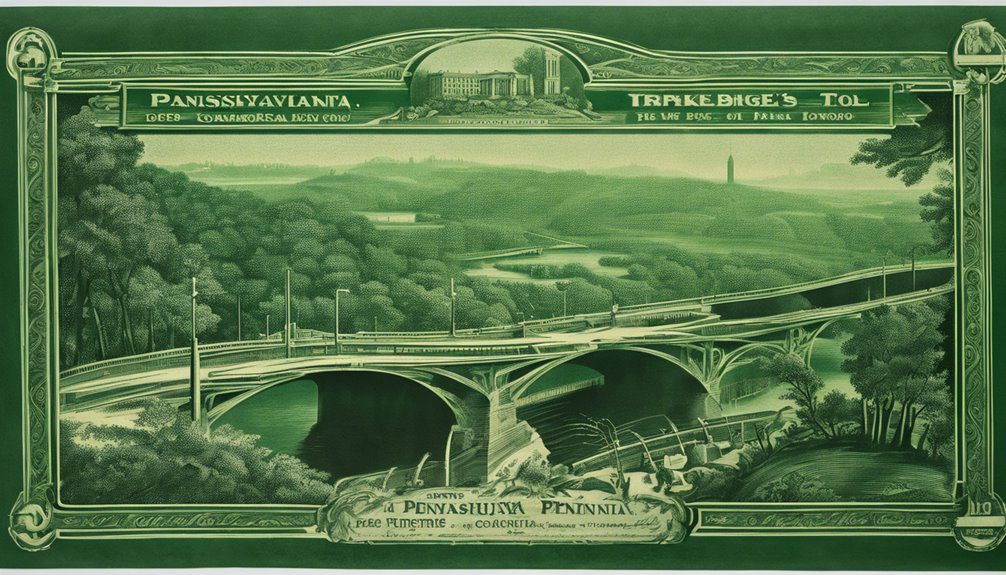When you consider the Pennsylvania Turnpike Toll Bond, it's essential to understand its role in funding critical infrastructure. These bonds, backed by toll revenues, not only support maintenance but also enable expansion to meet growing traffic demands. However, the implications of this funding strategy extend beyond just roads. What happens when economic conditions shift, or when public needs evolve? The answers could reshape the future of transportation in Pennsylvania, and it's worth exploring how these factors intertwine.
Overview of Toll Bonds

When you think about funding infrastructure, toll bonds often come to mind as a vital financial tool used by governments and agencies. These bonds provide a mechanism for raising capital specifically for the construction, maintenance, and improvement of toll facilities, like highways and bridges.
By issuing toll bonds, authorities can secure upfront funds needed for large projects without waiting for tax revenue to accumulate.
Toll bonds are typically backed by the revenue generated from tolls collected on the roads they finance. This means that when you pay a toll, a portion of that money goes toward repaying the bondholders.
This revenue-based funding model aligns the interests of both the investors and the public, as efficient management of the toll facility can lead to timely repayments.
You'll find that toll bonds help bridge the gap between immediate financial needs and long-term infrastructure planning. They allow for quicker project initiation, which can lead to enhanced transportation networks and improved public safety.
How Toll Bonds Function
Toll bonds function as a straightforward financial instrument that allows governments to fund infrastructure projects efficiently. When you invest in toll bonds, you're essentially lending money to a government entity, which promises to pay you back with interest over time. This funding helps cover the costs of constructing or maintaining toll roads and bridges.
The process begins with the government issuing bonds to raise capital. Investors buy these bonds, providing the necessary funds upfront. In return, you receive periodic interest payments, known as coupon payments, until the bond matures. At maturity, you'll get back your initial investment.
Toll revenues generated from the roads or bridges funded by these bonds are used to repay bondholders. This creates a direct link between the tolls collected and the bond payments, ensuring that the infrastructure can sustain itself financially.
You'll find that toll bonds appeal to many because they often come with a level of security; the revenue from tolls acts as collateral.
History of the Pennsylvania Turnpike

The Pennsylvania Turnpike, often hailed as one of America's first modern toll roads, has a rich history that dates back to its opening in 1940. You might find it interesting that the idea of the turnpike emerged during the Great Depression, as a way to create jobs and stimulate the economy.
Designed with efficiency and safety in mind, the road featured limited access points and a wide, smooth design that allowed for high-speed travel.
As you explore its history, you'll notice that the original route stretched 160 miles, connecting Irwin to Carlisle. It quickly gained popularity, with millions of vehicles traversing its lanes each year.
By the 1950s, expansion began, adding more miles and connecting to other major highways. This expansion helped facilitate interstate travel, making it a vital artery for commerce and tourism.
Throughout the decades, the turnpike has undergone numerous upgrades and renovations to keep up with increasing traffic demands. You can see how it's evolved into a crucial part of Pennsylvania's infrastructure, a testament to innovative engineering and foresight.
The turnpike's legacy continues as it adapts to modern transportation needs.
Economic Impact of Toll Bonds
As the Pennsylvania Turnpike evolved, its financial strategies also adapted to support ongoing development and maintenance. Toll bonds play a crucial role in this process, allowing you to fund large infrastructure projects without relying solely on state budgets. By issuing these bonds, the Turnpike can secure immediate capital for necessary upgrades and expansions, which ultimately boosts economic activity across the region.
When you invest in toll bonds, you're helping to create jobs during construction and maintenance phases. This influx of employment opportunities can stimulate local economies, increasing spending in surrounding communities.
Additionally, improved infrastructure enhances accessibility, attracting businesses and encouraging tourism, which further contributes to economic growth.
The toll revenue generated from these bonds ensures that you can pay back investors while also covering operational costs. This cycle of investment, revenue generation, and reinvestment fosters a sustainable economic environment.
However, it's essential to strike a balance between toll rates and affordability for drivers to ensure continued usage of the Turnpike.
Management of Debt and Capital

Effective management of debt and capital is essential for the Pennsylvania Turnpike to maintain its financial health. You need to understand that balancing these elements directly impacts the Turnpike's ability to fund maintenance, improvements, and operations.
By strategically managing debt, the Turnpike can ensure it meets its obligations without sacrificing service quality or infrastructure investment. Monitoring interest rates and refinancing opportunities can lead to significant savings.
You should consider how the timing of bond issuances can affect overall financing costs. When you manage capital effectively, you're not only ensuring funds are available for immediate needs but also for long-term projects that enhance safety and efficiency.
Additionally, maintaining a solid credit rating is crucial. It influences borrowing costs and investor confidence. You'll want to focus on maintaining transparent financial practices and communicating effectively with stakeholders.
This builds trust and can lead to better funding opportunities. Furthermore, understanding the importance of surety bonds is vital, as they help ensure compliance with local laws and regulations while protecting against financial loss.
Future of Turnpike Funding
Navigating the future of Turnpike funding requires a strategic approach to adapt to changing economic conditions and transportation needs.
As you consider the upcoming challenges, think about diversifying funding sources beyond traditional toll revenues. Exploring public-private partnerships could provide fresh capital and innovative solutions to enhance infrastructure.
You should also embrace technology to improve efficiency and reduce costs. Implementing smart tolling systems can streamline operations, making it easier to manage traffic and collect fares.
Additionally, consider the increasing importance of sustainability. Investing in eco-friendly projects might attract additional funding from environmentally conscious investors and agencies.
It's vital to engage stakeholders, including local communities and transportation advocates, in discussions about future plans. Their insights can help shape priorities and ensure that projects meet the needs of all users.
Furthermore, keeping an eye on federal and state funding opportunities can bolster your resources, especially as infrastructure funding evolves.
Key Takeaways and Insights

Understanding the key takeaways from the Pennsylvania Turnpike toll bond discussions can significantly influence future funding strategies.
First, you should recognize that toll bonds are crucial for financing infrastructure improvements. They provide a means to raise immediate capital for necessary upgrades while allowing for the gradual repayment through toll revenue.
Next, consider the importance of transparency in these discussions. Stakeholders need clear, accessible information about how funds are allocated and the anticipated impact on toll rates. This transparency can build trust with the public, leading to greater support for future toll adjustments.
Also, keep in mind the role of economic factors. Fluctuations in traffic volume and fuel prices can directly affect toll revenue and, consequently, the viability of bond financing. You'll want to stay informed about these trends to make sound financial decisions.
Lastly, collaboration is key. Engaging with local governments, businesses, and community members can result in more comprehensive funding strategies that address the needs of all stakeholders involved. Additionally, understanding the role of surety companies in providing financial backing for bonds is essential for evaluating funding options.
Conclusion
In conclusion, the Pennsylvania Turnpike Toll Bond is vital for maintaining and expanding the infrastructure that supports your daily travel. By understanding how these bonds work and their historical significance, you can appreciate their role in economic growth and job creation. As the Turnpike evolves to meet future demands, you'll see continued investment in its funding. Staying informed about these developments helps you recognize the importance of this essential transportation system in your community.


